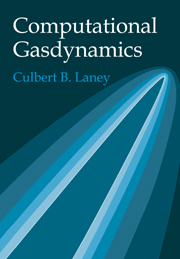Book contents
- Frontmatter
- Contents
- Preface
- Chapter 1 Introduction
- Part I Gasdynamics Review
- Part II Computational Review
- Part III Basic Principles of Computational Gasdynamics
- Part IV Basic Methods of Computational Gasdynamics
- Part V Advanced Methods of Computational Gasdynamics
- Chapter 20 Flux Averaging I: Flux-Limited Methods
- Chapter 21 Flux Averaging II: Flux-Corrected Methods
- Chapter 22 Flux Averaging III: Self-Adjusting Hybrid Methods
- Chapter 23 Solution Averaging: Reconstruction–Evolution Methods
- Chapter 24 A Brief Introduction to Multidimensions
- Index
Chapter 23 - Solution Averaging: Reconstruction–Evolution Methods
Published online by Cambridge University Press: 07 December 2009
- Frontmatter
- Contents
- Preface
- Chapter 1 Introduction
- Part I Gasdynamics Review
- Part II Computational Review
- Part III Basic Principles of Computational Gasdynamics
- Part IV Basic Methods of Computational Gasdynamics
- Part V Advanced Methods of Computational Gasdynamics
- Chapter 20 Flux Averaging I: Flux-Limited Methods
- Chapter 21 Flux Averaging II: Flux-Corrected Methods
- Chapter 22 Flux Averaging III: Self-Adjusting Hybrid Methods
- Chapter 23 Solution Averaging: Reconstruction–Evolution Methods
- Chapter 24 A Brief Introduction to Multidimensions
- Index
Summary
Introduction
This chapter concerns reconstruction–evolution methods, also called solution-averaged or solution-reconstructed methods. Before continuing, you may wish to review the earlier discussions of reconstruction–evolution methods found in Sections 13.6, 17.3, and 18.3. The reconstruction–evolution methods seen in those earlier sections were all first-order accurate. This chapter concerns second- and higher-order accurate methods. In some cases, solution-averaged methods differ from flux-averaged methods in relatively minor ways. For example, the solution-averaged method might use an average like f((x + y)/2), whereas the flux-averaged method might use an average like (f(x) + (y))/2. However, in general, solution-averaged methods use elaborate physical modeling of a sort not possible in flux-averaged methods, making them far more complex.
This chapter describes five reconstruction–evolution methods. Section 23.1 concerns Van Leer's reconstruction–evolution method, better known as MUSCL. Section 23.2, concerns the Colella–Woodward reconstruction–evolution method, better known as PPM. Section 23.3 describes two reconstruction–evolution methods devised by Anderson, Thomas, and Van Leer, also often called MUSCL methods, that strongly resemble the flux-limited methods devised by Chakravarthy and Osher seen in Section 20.3. Section 23.4 describes the Harten–Osher reconstruction–evolution method, better known as the UNO method. Finally, Section 23.5 describes the Harten–Engquist–Osher–Chakravarthy reconstruction–evolution methods, better known as ENO methods. Do not confuse the finite-volume ENO methods seen in Section 23.5 with the finite-difference ENO methods seen in Section 21.4. The two classes of methods have basically one thing in common: both use ENO reconstruction, as described in Chapter 9, one to reconstruct the solution and the other to reconstruct the flux.
- Type
- Chapter
- Information
- Computational Gasdynamics , pp. 565 - 596Publisher: Cambridge University PressPrint publication year: 1998

